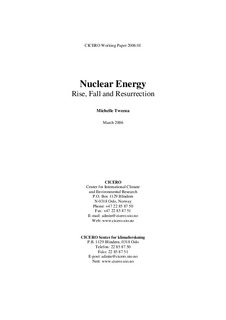| dc.contributor.author | Twena, Michelle | nb_NO |
| dc.date.accessioned | 2014-03-17T14:31:21Z | |
| dc.date.available | 2014-03-17T14:31:21Z | |
| dc.date.issued | 2006 | nb_NO |
| dc.identifier.issn | 0504-452X | nb_NO |
| dc.identifier.uri | http://hdl.handle.net/11250/192298 | |
| dc.description.abstract | This paper charts the rise, fall and potential resurrection of the civilian nuclear power industry over the past fifty years in the UK. The role of actors, interests, institutions and ideas are explored using Baumgartner and Jones’s punctuated equilibrium model of agenda-setting. The study provides some validation of their theory, which posits that the interaction between policy image (how a policy is portrayed) and policy venue (the institutions with jurisdiction over the issue) serves as a mechanism for promoting stability and change in the political system. However, weaknesses are identified in the model’s ability to incorporate external events, international dimensions, and the role of social norms and cultural values. In conclusion, the paper calls for a more constructivist epistemological approach in future agenda-setting research. | nb_NO |
| dc.language.iso | eng | nb_NO |
| dc.publisher | CICERO Center for International Climate and Environmental Research - Oslo | nb_NO |
| dc.relation.ispartof | CICERO Working Paper | nb_NO |
| dc.relation.ispartofseries | CICERO Working Paper;2006:01 | nb_NO |
| dc.title | Nuclear Energy: Rise, Fall and Resurrection | nb_NO |
| dc.type | Working paper | nb_NO |
| dc.source.pagenumber | 35 | nb_NO |
